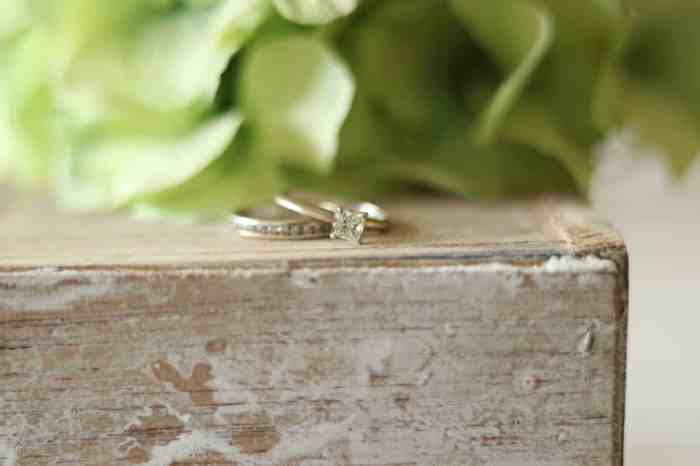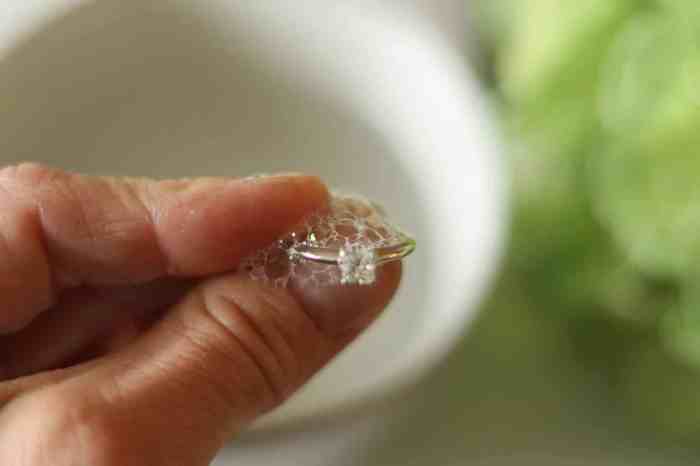Choosing the right jewelry cleaner for different metals is key to keeping your bling sparkling and preventing damage. From delicate gold chains to sturdy silver bracelets, each metal reacts differently to various cleaning solutions. Understanding the properties of your jewelry – its hardness, reactivity, and the type of stones it contains – is crucial before you even think about grabbing that cleaning solution.
Ignoring these differences can lead to dullness, scratches, or even irreversible damage. This guide will walk you through the best cleaning methods for different metals and gemstones, helping you keep your favorite pieces looking their best for years to come.
We’ll explore various cleaning methods, from ultrasonic cleaners and commercial dips to simple homemade solutions. We’ll also delve into safe cleaning practices, including pre-cleaning steps and how to handle delicate pieces. Finally, we’ll cover preventing damage and maintaining your jewelry to ensure it stays dazzling.
Identifying Metal Types

Knowing your jewelry’s metal composition is crucial for proper cleaning. Different metals react differently to various cleaning agents, and using the wrong method can lead to damage, dulling, or even irreversible harm. This section will help you identify common jewelry metals and understand their unique cleaning needs.Different jewelry metals possess varying degrees of hardness and reactivity, dictating how they should be cleaned.
For instance, softer metals like silver are more susceptible to scratches, while harder metals like platinum are more resistant. Similarly, reactive metals like silver can tarnish more readily than less reactive metals like gold. Understanding these properties helps you choose the right cleaning approach and prevent damage.
Metal Properties and Cleaning Methods
The table below summarizes the properties of four common jewelry metals and their appropriate cleaning methods. Remember, always test any cleaning solution on an inconspicuous area first before applying it to the entire piece.
| Metal | Hardness | Reactivity | Appropriate Cleaning Methods |
|---|---|---|---|
| Gold (14k, 18k, 24k) | Relatively soft; prone to scratching | Low reactivity; resists tarnishing | Warm soapy water, mild jewelry cleaner (avoid harsh chemicals); ultrasonic cleaning is generally safe but should be done with caution. |
| Silver | Relatively soft; prone to scratching | High reactivity; tarnishes easily | Silver polishing cloths, silver dips (use sparingly), mild soapy water; avoid abrasive cleaners. |
| Platinum | Hard and durable; resistant to scratching | Very low reactivity; highly resistant to tarnishing | Warm soapy water, mild jewelry cleaner; ultrasonic cleaning is generally safe. |
| White Gold (often rhodium-plated) | Similar to yellow gold in hardness; rhodium plating adds durability | Low reactivity; the rhodium plating resists tarnishing, but it can wear off. | Warm soapy water; avoid abrasive cleaners that could damage the rhodium plating. Replating may be needed periodically. |
Types of Jewelry Cleaners

Choosing the right jewelry cleaner depends heavily on the type of metal and the level of grime you’re dealing with. There are several options available, each with its own set of advantages and disadvantages. Understanding these differences will help you keep your precious pieces sparkling without causing damage.So, let’s dive into the different ways you can clean your jewelry.
We’ll explore the pros and cons of each method, highlighting what works best for which materials.
Ultrasonic Cleaners
Ultrasonic cleaners use high-frequency sound waves to create vibrations in a liquid solution, dislodging dirt and debris from intricate jewelry pieces. This method is particularly effective for cleaning delicate items with hard-to-reach areas, like diamond rings or intricate necklaces. However, it’s crucial to note that the ultrasonic process can be too harsh for certain softer stones and metals.
For example, opals and pearls are particularly vulnerable to damage from the vibrations, and some softer metals might get scratched. The cost of an ultrasonic cleaner varies depending on size and features, ranging from affordable home units to professional-grade models.
Commercial Jewelry Dips
Commercial jewelry dips are pre-packaged solutions designed for quick and easy cleaning. These dips usually come in small containers and require only a brief immersion of your jewelry. They are convenient and generally inexpensive, making them a popular choice for occasional cleaning. However, the chemical composition of these dips can vary significantly, and some may contain harsh chemicals that could damage certain metals or stones if used improperly or for extended periods.
Always check the product label for specific metal compatibility. Additionally, they might not be as effective as other methods for removing stubborn dirt.
Homemade Cleaning Solutions
Homemade cleaning solutions offer a cost-effective and customizable approach to jewelry cleaning. Simple solutions using mild soap and warm water are often sufficient for regular cleaning of most metals. More robust solutions can be made with ingredients like baking soda or ammonia (for specific metals only – use caution!), but it’s crucial to research the appropriate solution for your specific jewelry type.
The biggest advantage is control over ingredients and cost. However, improperly mixing solutions or using unsuitable ingredients can damage your jewelry.
Common Ingredients in Commercial Cleaners and Their Effects
Understanding the ingredients in commercial jewelry cleaners is vital for safe and effective cleaning. Here are some common components and their potential effects:
- Ammonia: Effective at dissolving grime, but can be harsh on certain metals like silver and gold if used too frequently or in high concentrations. It’s generally not recommended for pearls, opals, or other porous stones.
- Detergents (e.g., mild soap): Generally safe for most metals and stones when used in dilute solutions. They help lift away dirt and grease.
- Surfactants: These reduce surface tension, allowing the cleaning solution to penetrate crevices and lift away dirt. Generally safe when used in commercial formulations designed for jewelry.
- Mild Acids (e.g., citric acid): Can be effective at removing tarnish from certain metals, but overuse can damage the surface. Always test on an inconspicuous area first.
Safe Cleaning Practices
Cleaning your jewelry properly is crucial for maintaining its shine and longevity. Ignoring proper cleaning techniques can lead to damage, dullness, and even loss of precious stones. Before you even think about using any cleaning solution, however, a pre-cleaning step is essential.Pre-cleaning your jewelry removes loose dirt and debris that could scratch the surface during the cleaning process.
Think of it like prepping your car before a wash – you wouldn’t just hose it down without first brushing away the loose mud, would you? This initial step prevents abrasive particles from causing micro-scratches, especially on softer metals like gold or silver.
Pre-Cleaning Jewelry
Before applying any cleaning solution, gently brush away loose dirt and debris using a soft-bristled brush, such as a toothbrush with soft bristles or a specialized jewelry cleaning brush. Pay close attention to crevices and intricate settings where dirt tends to accumulate. A gentle stream of lukewarm water can help dislodge stubborn particles. For delicate pieces, use a soft cloth to wipe away loose debris.
Remember, the goal here is to prepare the jewelry for the actual cleaning process without causing any damage.
Safe Cleaning Methods
Several methods exist for cleaning jewelry safely, each suitable for different materials and levels of soiling. Choosing the right method depends on the metal type and the extent of the dirt or tarnish.
- Using a commercial jewelry cleaning solution: Follow the instructions on the product label precisely. Typically, this involves soaking the jewelry in the solution for a short period (usually a few minutes), then gently brushing it with a soft brush. Rinse thoroughly with lukewarm water and pat dry with a soft, lint-free cloth. Avoid prolonged soaking, as this can damage some metals.
- Employing an ultrasonic cleaner: Ultrasonic cleaners use sound waves to dislodge dirt and grime. Place your jewelry in the cleaning solution recommended by the manufacturer and turn on the device for the appropriate duration (check the manual). This method is effective but should be avoided for delicate pieces, porous stones (like pearls or opals), or jewelry with intricate settings that could be damaged by the vibrations.
Always double-check the compatibility of your jewelry with ultrasonic cleaning.
- Utilizing homemade cleaning solutions: For some metals, simple homemade solutions can work wonders. For example, a mixture of warm water and mild dish soap can effectively clean many pieces. Gently rub the jewelry with a soft cloth, rinse thoroughly, and dry immediately. Other options include a paste of baking soda and water (for tarnished silver), but always test a small, inconspicuous area first to ensure no damage occurs.
Remember, homemade solutions might not be as effective as commercial ones for heavily soiled jewelry.
Cleaning Delicate Jewelry
Cleaning delicate jewelry requires extra care and attention to detail. The following visual guide illustrates the process:Imagine a delicate gold necklace with small pearls.
1. Preparation
Lay a soft, clean microfiber cloth on a flat, stable surface. This provides a cushioned work area to prevent accidental drops or scratches.
2. Inspection
Carefully examine the necklace for any loose pearls or damaged areas. Note any particularly fragile sections that need extra attention.
3. Gentle Cleaning
Using a soft, damp cloth (lukewarm water only), gently wipe the gold chain, being mindful not to apply too much pressure. Avoid harsh rubbing or scrubbing. For the pearls, use a separate, slightly damp cloth and gently wipe each pearl individually.
4. Rinsing
Rinse the necklace under a gentle stream of lukewarm water. Avoid high-pressure water streams.
5. Drying
Gently pat the necklace dry with a soft, clean microfiber cloth. Avoid rubbing vigorously. Allow the necklace to air dry completely in a safe, dust-free location before storing.
Dealing with Specific Jewelry Issues: Choosing The Right Jewelry Cleaner For Different Metals
Okay, so you’ve identified your metal and chosen your cleaner – awesome! But sometimes, jewelry needs a little extra TLC. This section tackles some common issues and provides solutions for getting your sparkly friends back to their best. We’ll cover tarnish removal, safe gemstone cleaning, and cleaning different types of jewelry settings.
Silver Tarnish Removal
Silver tarnishes due to a chemical reaction with sulfur in the air. Fortunately, there are several ways to combat this. For mild tarnish, a simple polishing cloth can often do the trick. For heavier tarnish, you can try a commercial silver cleaning dip, following the manufacturer’s instructions carefully. Alternatively, a paste made from baking soda and water can gently remove tarnish.
Apply the paste with a soft cloth, gently rub, rinse thoroughly, and dry immediately. Remember to always test any cleaning method on a small, inconspicuous area first.
Gold Jewelry Cleaning, Choosing the right jewelry cleaner for different metals
Gold is generally more resistant to tarnish than silver, but it can still accumulate dirt and grime. A mild soap and water solution, along with a soft-bristled brush, is usually sufficient. For stubborn dirt, a commercial jewelry cleaner specifically designed for gold can be used, again following the instructions closely. Avoid harsh chemicals or abrasive cleaners that could scratch the gold’s surface.
Gemstone Cleaning
Cleaning gemstones requires a gentle touch. The cleaning method will vary depending on the hardness and porosity of the stone. For example, diamonds, being the hardest gemstone, can usually withstand a more vigorous cleaning with a soft-bristled brush and mild soap. However, softer stones like opals or pearls require a much gentler approach – simply wiping them with a damp, soft cloth is often enough.
Avoid ultrasonic cleaners for porous stones as they can damage the stone’s structure. Always avoid harsh chemicals or abrasive cleaners on gemstones.
Cleaning Different Jewelry Settings
The type of setting impacts how you clean your jewelry. Prong settings, where the stone is held in place by small metal claws, need to be carefully cleaned to avoid dislodging the prongs. Use a soft-bristled brush and mild soap, paying attention to the areas around the prongs. Bezel settings, where the stone is surrounded by a metal frame, are generally easier to clean.
A soft cloth and mild soap are usually sufficient. Channel settings, where stones are set in grooves, can be tricky. Use a soft-bristled brush to carefully remove debris from the grooves. For all settings, always rinse thoroughly and dry immediately to prevent water spots.
Preventing Damage and Maintaining Jewelry
Proper storage and regular maintenance are key to keeping your jewelry looking its best and extending its lifespan. Neglecting these aspects can lead to scratches, tarnish, and even damage to delicate clasps and settings. This section Artikels practical strategies for preserving the beauty and value of your treasured pieces.
Jewelry Storage Recommendations
Storing jewelry correctly prevents scratches, tangling, and exposure to damaging elements. Individual storage is ideal, minimizing contact between pieces and preventing scratches. Soft-lined jewelry boxes or cases are excellent options. For necklaces and bracelets, consider using fabric-covered jewelry rolls or individual pouches to keep them from knotting. Avoid storing jewelry in damp areas, as moisture contributes to tarnish and corrosion.
For pieces you wear less frequently, consider using airtight bags with silica gel packets to absorb moisture and prevent tarnishing. Storing jewelry in a cool, dark, and dry place is best, away from direct sunlight and extreme temperatures.
Regular Jewelry Maintenance Tips
Regular maintenance between cleanings helps keep your jewelry sparkling and prevents the buildup of dirt and oils. After each wearing, gently wipe your jewelry with a soft, lint-free cloth to remove surface dust, oils, and perspiration. This simple act significantly reduces the frequency of deep cleaning and helps maintain the luster of your pieces. For delicate pieces, consider using a very soft, slightly damp cloth.
Avoid harsh chemicals or abrasive cleaners during this step. For pieces prone to tarnishing, consider using a polishing cloth designed specifically for the metal type.
Cleaning Frequency for Different Jewelry Types
| Jewelry Type | Metal | Cleaning Frequency | Notes |
|---|---|---|---|
| Everyday Rings | Sterling Silver | Weekly or as needed | More frequent cleaning due to constant exposure to skin oils and environmental elements. |
| Necklaces (worn daily) | Gold | Monthly | Gold is relatively resistant to tarnish, but regular cleaning maintains its shine. |
| Earrings (worn daily) | Platinum | Every 2-3 months | Platinum is highly durable and resistant to tarnish, requiring less frequent cleaning. |
| Statement pieces (worn occasionally) | Silver | As needed, before each wearing | Less frequent cleaning but important to check for tarnish before wearing. |
| Fine jewelry (diamonds, gemstones) | Various | Professionally cleaned annually or as needed | Professional cleaning ensures proper care for delicate settings and gemstones. |
Final Review
Keeping your jewelry sparkling doesn’t have to be a daunting task. By understanding the unique properties of different metals and gemstones, and by choosing the appropriate cleaning method, you can preserve the beauty and value of your precious pieces. Remember to always prioritize gentle cleaning techniques and appropriate storage to prevent damage and maintain your jewelry’s brilliance. With a little care and attention, your jewelry will continue to shine, reflecting your style and personality for years to come.
So, ditch the harsh chemicals and embrace the gentle art of jewelry care!
FAQ
Can I use the same cleaner for all my jewelry?
Nope! Different metals react differently to various cleaning agents. Using the wrong cleaner can damage or dull your jewelry.
How often should I clean my jewelry?
It depends on how often you wear it and your environment. Generally, cleaning every few weeks or months is a good rule of thumb, but more frequent cleaning might be necessary for frequently worn pieces.
What should I do if I accidentally damage my jewelry while cleaning it?
Take it to a professional jeweler for repair. Attempting to fix it yourself could cause further damage.
Are ultrasonic cleaners safe for all jewelry?
No, some delicate stones and settings can be damaged by ultrasonic cleaners. Always check if your jewelry is suitable before using one.
What’s the best way to store my jewelry to prevent tarnish?
Store your jewelry in a cool, dry place, ideally in a soft cloth or airtight container to prevent exposure to air and moisture.
